Random Reviews: Judge Dredd vs. the Dark Judges
Containing a simple story told well, this volume brings to eerily detailed life a tale of harrowing heroism in the face of hellish conditions
—by Nathan on August 25, 2025—
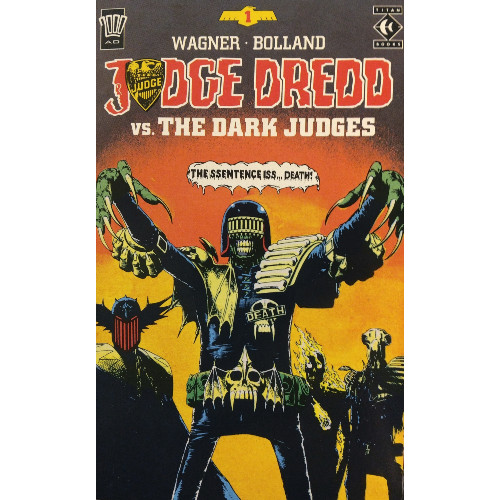
He is…the law!
And that's pretty much all I know about Judge Dredd.
In my scouring of comic book universes, I've found myself heavily immersed in the Marvel and DC multiverses, occasionally dipping my toes into waters where Image, Dark Horse, First Comics, and Boom! Studios swim. All of these publishers began in the country where I live, the United States, and though I've explored the workings of expats Chris Claremont, Alan Moore, Grant Morrison, and Neil Gaiman, most of that work has been for the aforementioned U.S.-situated publishers–Claremont's X-Men, Moore's Swamp Thing, Morrison's Animal Man, Gaiman's Eternals, to name a few.
I've not spent much time on the other side of the pond, exploring narratives written by British creators about British characters or set in the United Kingdom. V for Vendetta, originally serialized in British anthology Warrior, may be the only example I have of reviewing a story developed by Brits for Brits. For today's review, I'm taking on a narrative found in another U.K. magazine, the famous 2000 AD.
As I've scoured the comics multiverse, I've also been digging through the archives of The Last Comic Shop, a comic review podcast I enjoy listening to, and I recently stumbled upon an episode reviewing the material covered by this volume. As I tend to want to read what LCS reviews before listening to an episode, I picked up a small, mass market paperback reprinting these adventures in black-and-white. I enter this story with no previous knowledge of Judge Dredd, no prior experience with his adventures. I know Karl Urban and Sylvester Stallone played him in two different movies, and I know Stallone committed the cardinal sin of removing his helmet. Other than that, I'm dropping into the world of Mega-City One blind…with only a sense of Dredd guiding me.
Judge Dredd vs. The Dark Judges
Writers: John Wagner and Alan Grant
Penciler: Brian Bolland
Inker: Brian Bolland
Letterer: Tom Frame
Issues: 2000 AD Progs #149-151 and Progs #224-228 (short for "programme")
Volume Publication Date: September 1988
Issue Publication Dates: January 1980-February 1980, August 1981-September 1981
Publisher: IPC Magazines (2000 AD installments publisher), Titan Books (volume)
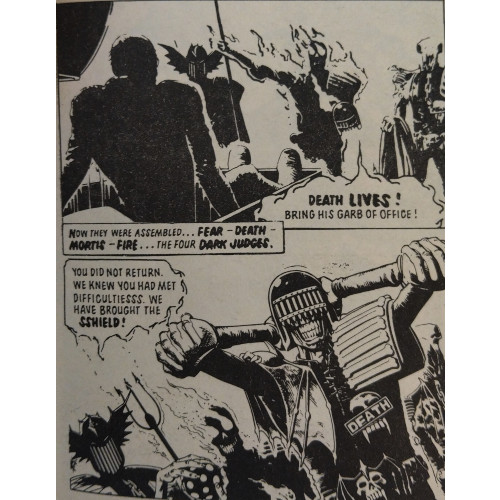
I'm not much of a "comic issue cover" guy, probably because I collect most of what I read in volumes. When reading an issue, I'll check the cover out, admire the art for a moment and note the text, but then it's off to the story inside. I say this because Brian Bolland's covers are often cited as amazing and seem to comprise the bulk of his industry work. He's done his fair share of interiors, including many more 2000 AD Judge Dredd stories, and two of the most popular narratives I can think of that he illustrated are his and Moore's Batman: The Killing Joke and his and Mike Barr's Camelot 3000. Both narratives gave me a sense of Bolland's artistic capabilities beyond his covers, specifically his ability to craft remarkably detailed characters and tell a coherent narrative.
Strip the color away from those stories and you get even a greater appreciation for Bolland's work, I feel. What drew me to the story may have been the podcast, but what drew me into the story once I began reading was Bolland's work. I don't quite know how the format would look if I read these "progs" in a standard-sized volume as opposed to the mass market paperback I picked up, and I wondered (as I did for The Untold Legend of the Batman) if the experience would be lessened. In this format, pages are about 1-3 panels each, drawing your attention to individual images. You're not reading six, seven, eight panels a page, crowded together to maximize dialogue or story beats. You're supposed to be a little more methodical here.
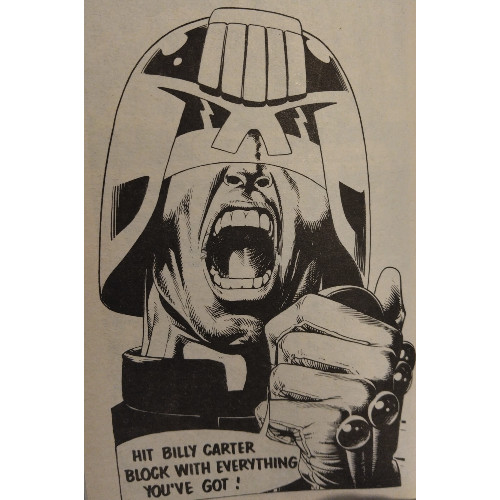
That structure allows Bolland to shine, particularly in the way he develops characters with fantastic detail. Faces are his specialty, especially when they're deep in concentration or wracked with pain or guilt, lips curling, eyes clenched shut, teeth pressed together, brows furrowed. His designs for the Dark Judges–Death, Fear, Mortis, and Fire–are each unique and repugnant in their own way, whether it's through the horror of Death's decaying face or the macabre realism of Mortis' horse skull. The amusing part about all this, Bolland's aptitude with faces, is how often those faces are covered, typically by helmets. There are a few characters, such as the telepathic Judge Anderson, whose faces are fully revealed, but the bulk of these stories' primary characters are mostly covered. This means Bolland needs to wring tension and emotion out of the lower halves of faces, which he does just as well as with a full face.
Wagner, with some help from writer Alan Grant, works with Bolland to develop a story that reads well even if you enter it knowing nothing about Judge Dredd…cause it's not really about Judge Dredd (which I'll touch on in a moment). Through the Dark Judges–first Death on his own and then Death paired with Fear, Mortis, and Fire–Wagner and Grant develop terrifying adversaries. Hailing from a universe where the Judges determined life itself was a crime (as it's living people who ultimately commit wrongs, so if no one's alive, no crimes can occur), the Dark Judges have slipped into Dredd's reality and are determined to eradicate all life here as well. The concept is simple, yet when taken to as violent extremes as it is, the plot makes for engaging reading.
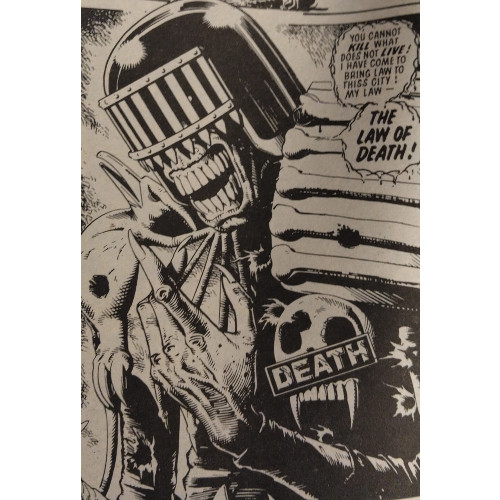
This isn't one of those stories where, if you dig down deep enough, you might see a glimmer of truth in the villains' philosophy. We aren't talking Thanos attempting to bring ecological balance to the universe by eradicating half of all life. Thanos has a strange logic to his scheming, one which places him in the role of the misunderstood hero of his own story. If you accept the problem (ecological disharmony), you recognize the logic behind the plan (eradicate half of all life), even if you don't agree with it (and you really, really shouldn't). The Judges certainly see themselves this way, but viewing life itself as a crime feels like several steps too far for me. And I'm not disappointed I don't get to relate as well to the walking skeletons as I do the multi-chinned purple alien. The insanity of why the Judges act as they do makes them all the more terrifying.
An extended sequence in the volume's second half where the four Dark Judges spread their violence throughout a massive apartment block, causing death in all manner of hateful ways to completely unsuspecting victims, etches the insanity and horror of their actions in the reader's mind. Buoyed by the seeming justice of their cause, the Judges run amok, creating a thoroughly chilling series of panels where Bolland can toy with all manner of deaths as Grant and Wagner direct him. The violence seems somewhat mindless at times, not overly gory, leaving just enough to the imagination. The scene maybe drags on to the point of "Okay, we get it, the Dark Judges are brutal," but when it initiates, Grant, Wagner, and Bolland showcase the devastating powers and drive of these four Judges. Chilling stuff, this.
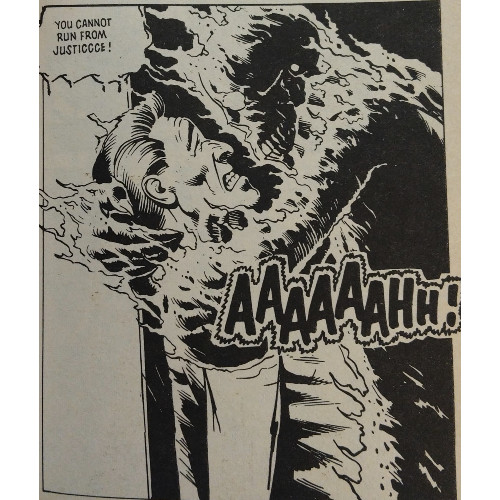
I mentioned Dredd takes a bit of a backseat in these narratives, and the creators do favor other characters in this story. I get why: Dredd had been around since the second 2000 AD "prog," and I assume had received decent characterization across multiple narratives. The primary focus lies on the Dark Judges and Judge Anderson, the officer with telepathic abilities. Anderson becomes the primary protagonist as she struggles to resist the Dark Judges' abilities, particularly Death in the first half, and a seemingly Pyrrhic victory at the end of that first half is nicely overturned, allowing her to return to play a strong role in the second portion.
Dredd? He's here to smash things, primarily. If you're familiar with the "Gaze into the fist of Dredd!" panel that occasionally circles around comic book fandoms on Reddit, this is the source. Dredd punches one of the Dark Judges through his stupid face, through his stupid head, mocking the villain's own catchphrase as a final bit of poetic justice. Though we don't receive much in the way of backstory or development, Dredd continually proves himself incredibly staunch in the face of great odds. Dude's tough inside and out, taking risks to fulfill his duty and making difficult decisions that place his fellow Judges in harm's way for the protection of Mega-City One. He's not cruel or callous…he is caring, but he just knows the risks he and his fellow officers take every day fighting goons like these death metal abominations.
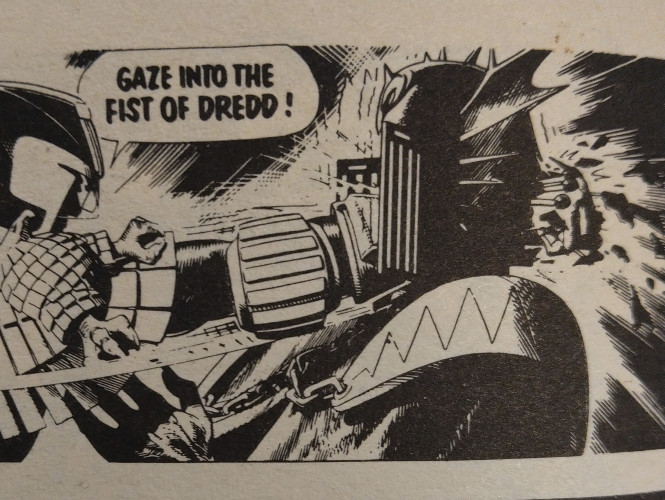
There is simplicity to the story, yes. Bad Judges show up to massacre people, good Judges swing in to put an end to their rampage. The Dark Judges are appropriately terrifying–think of a world where life itself was outlawed and punishable only by death, try to get into that mindset even just an inkling, and you see how chaotic a world could become if people wielded power to bring that about. Much of the groundwork has already been laid for our main hero: he's burly, he's no-nonsense, yet he possesses enough humanity to protect Mega-City One wholeheartedly, even in the face of the horrors presented. If you're not overly swayed by the premise, then I invite you to come (and stay) for the art. Brian Bolland works wonders, his people adding a layer of reality to his gritty future. In black-and-white, the details are all the more present, from the clenched jaw of a determined officer of the law to the shambling skeleton of a Judge with no concern for order.